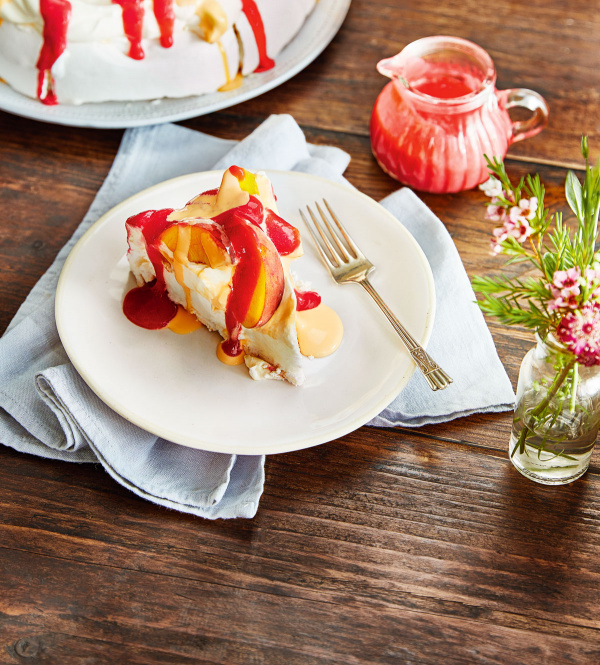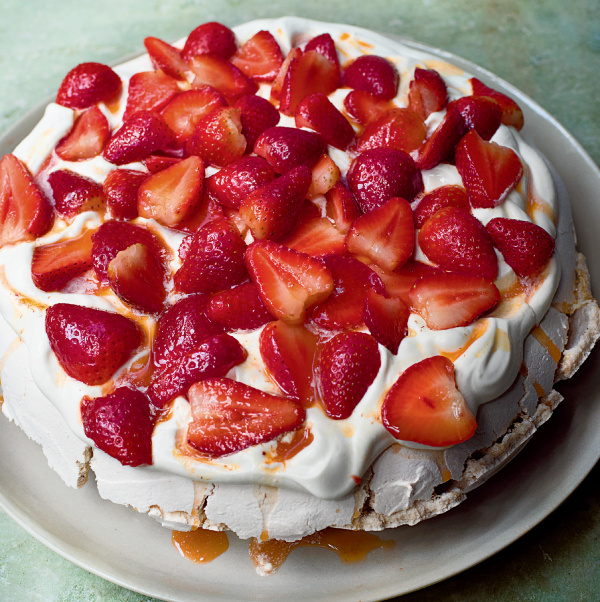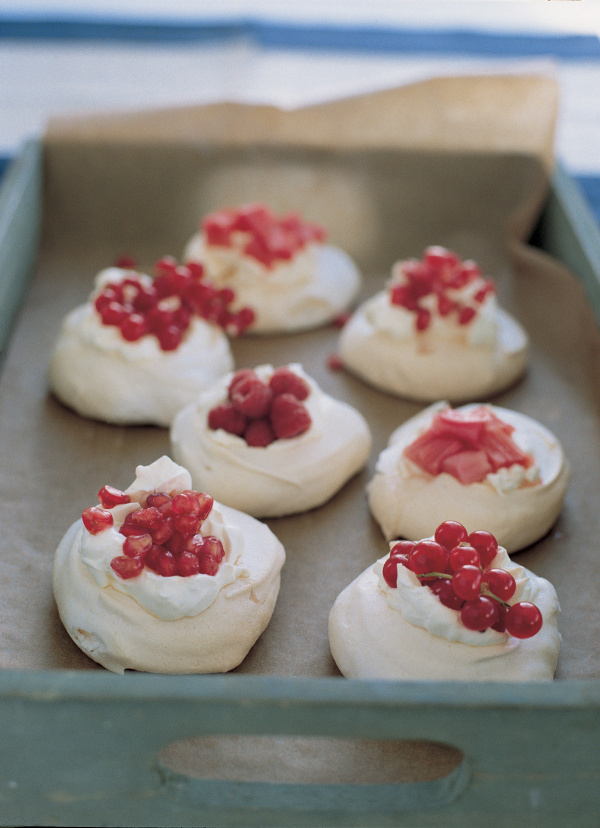Peach Melba Pavlova
by NigellaIntroduction
My Peach Melba Pavlova is a dream of a dessert: crisp-edged meringue with a marshmallow centre, spread with softly whipped cream, covered with golden peach wedges and drizzled with a sauce of pureed raspberries, then custard. The custard is an unconventional touch, to be sure, but you have the yolks over from making the pavlova and just one taste of the completed creation will ensure you won’t regret the extra effort!
I like to make the pavlova base and the custard a day ahead. Keep the pavlova in airtight container in a cool place as humidity is the enemy of meringue (if I’m not using my oven further, I wait till both pav and oven are cold, and stash the pav base in it, making sure I’ve left a Post-It Note on the oven to tell anyone, my forgetful self included, not to switch it on!) and, once the covered custard is cool, store it safely in the fridge.
My Peach Melba Pavlova is a dream of a dessert: crisp-edged meringue with a marshmallow centre, spread with softly whipped cream, covered with golden peach wedges and drizzled with a sauce of pureed raspberries, then custard. The custard is an unconventional touch, to be sure, but you have the yolks over from making the pavlova and just one taste of the completed creation will ensure you won’t regret the extra effort!
I like to make the pavlova base and the custard a day ahead. Keep the pavlova in airtight container in a cool place as humidity is the enemy of meringue (if I’m not using my oven further, I wait till both pav and oven are cold, and stash the pav base in it, making sure I’ve left a Post-It Note on the oven to tell anyone, my forgetful self included, not to switch it on!) and, once the covered custard is cool, store it safely in the fridge.

Share or save this
Ingredients
Serves: 8
FOR THE PAVLOVA BASE
- 4 large egg whites (reserve the yolks for the custard)
- 1 pinch of fine sea salt
- 250 grams caster sugar
- 2 teaspoons cornflour
- 1 teaspoon white wine vinegar
FOR THE CUSTARD
- 4 egg yolks (reserved from the pavlova base)
- 30 grams caster sugar
- 1 teaspoon cornflour
- pinch of fine sea salt
- 250 millilitres double cream
- 150 millilitres full fat milk
- 2 teaspoons vanilla extract
FOR THE RASPBERRY SAUCE
- 300 grams raspberries
- 2 tablespoons icing sugar
- 1 teaspoon lemon juice
TO TOP THE PAVLOVA BASE
- 350 millilitres double cream
- 3 - 4 ripe yellow-fleshed peaches (stoned and cut into long slices)
FOR THE PAVLOVA BASE
- 4 large egg whites (reserve the yolks for the custard)
- 1 pinch of fine sea salt
- 1¼ cups superfine sugar
- 2 teaspoons cornstarch
- 1 teaspoon white wine vinegar
FOR THE CUSTARD
- 4 egg yolks (reserved from the pavlova base)
- 2 tablespoons superfine sugar
- 1 teaspoon cornstarch
- pinch of fine sea salt
- 1 cup heavy cream
- ⅔ cup whole milk
- 2 teaspoons vanilla extract
FOR THE RASPBERRY SAUCE
- 10 ounces raspberries
- 2 tablespoons confectioners' sugar
- 1 teaspoon lemon juice
TO TOP THE PAVLOVA BASE
- 1½ cups heavy cream
- 3 - 4 ripe yellow-fleshed peaches (stoned and cut into long slices)
Method
- Heat the oven to 180°C/160°C Fan/350°F (though it would be better to have the fan off). Meanwhile, line a flat baking sheet with baking paper. Draw round a 22cm-diameter (9-inch) plate or cake tin to create a circle in the middle of the paper.
- For the base, whisk the egg whites with the pinch of fine sea salt using an electric whisk until satiny peaks form. Beat in the sugar a spoonful at a time until the meringue is stiff and shiny - be patient: the trick is to whisk fast and add sugar slowly.
- Sprinkle over the cornflour and vinegar then, by hand using a spatula, gently but thoroughly fold everything together. Dab the paper with a little meringue mixture on the 4 corners (on the side you’ve drawn the circle) then turn it the other way around, so the paper is stuck to the baking sheet. Pile your pavlova mixture within the circle you’ve drawn, then, with a small cranked palette knife, form it into a flat-topped, straight-sided fat disc, following your circle as a guide and smoothing the sides and top.
- Place in the oven, then immediately turn the temperature down to 150°C/130°C Fan/300°F (again, fan off if you can) and cook for 1 hour. The top should feel crisp if you tap it.
- Leave the oven door ajar while you allow the pavlova base to cool inside for 15-20 minutes. Then take it out (still on its baking sheet) and leave it to cool completely. The minute it’s properly cold, you can store it in an airtight container until the next day, if you like. I recommend a large cake caddy, though if you have a double-oven you could stash it in a cold oven till needed.
- While the pavlova base is baking, get on with the custard. In a wide measuring jug, and using a flat hand whisk, whisk together the reserved yolks with the caster sugar, cornflour and pinch of salt.
- Pour the cream and milk into another measuring jug and heat in the microwave for 2 minutes on high (or simply warm in a pan) then, whisking as you go, pour slowly into the egg yolk mixture, scraping up any egg yolk stuck to the bottom of the jug.
- Pour into a wide-ish, heavy-based saucepan, scraping it out with a spatula, and whisk again just to make sure everything’s well combined. Put the pan over a medium-low heat and cook, stirring constantly with a wooden spoon (though keep the hand whisk nearby) for 6-7 minutes until the custard has thickened; towards the end of this time, regularly take the pan off the heat and give the custard a brisk whisk. The custard won’t be enormously thick, though it will thicken further once it’s been in the fridge overnight. To test if it’s about right for now, coat the back of the wooden spoon and draw through the custard with your finger – it should leave a clean stripe.
- Take the pan off the heat and whisk in the vanilla extract, then pour back into a measuring jug to cool. Press a slightly dampened scrunched piece of baking paper on top to stop a skin forming (or use cling film) and leave for an hour or two to cool, then put in the fridge for at least 6 hours or overnight.
- Just before serving, blend the raspberries with half the icing sugar and half the lemon juice till completely liquidized. I like to do this in a bullet blender as it makes it smooth enough, I feel, to serve as it is. If you’re using a processor, you’ll have to push it through a strainer or fine sieve. But first, taste the sauce to see if you need the remaining icing sugar or lemon juice, whizzing it up again if you’ve added more. Strain the sauce if needed.
- I prefer to assemble the pavlova at the last minute. Don’t worry that your cold pavlova base is cracked on top and slightly splintered around the sides; this is inevitable if we want a marshmallowy centre and we most certainly do! Delicately invert the meringue onto your plate of choice, then peel off the baking paper, so that the tender, squidgy side is now uppermost.
- Whip the double cream for the topping with an electric whisk until it is softly thickened, but not stiff. Spread the cream over the inverted pavlova on top of the marshmallowy base, swirling it to create texture with dips and peaks.
- Arrange the peach segments higgledy piggledy on top of the cream. With a teaspoon, drizzle a little of the raspberry sauce over, and then do the same, a little more exuberantly, with the custard, zig-zagging it so some drips enticingly down the sides.
- Cut the pavlova into slices, pouring more raspberry sauce and custard over as you serve, and do let your guests pour even more of both as wished.
- Heat the oven to 180°C/160°C Fan/350°F (though it would be better to have the fan off). Meanwhile, line a flat baking sheet with baking paper. Draw round a 22cm-diameter (9-inch) plate or cake tin to create a circle in the middle of the paper.
- For the base, whisk the egg whites with the pinch of fine sea salt using an electric whisk until satiny peaks form. Beat in the sugar a spoonful at a time until the meringue is stiff and shiny - be patient: the trick is to whisk fast and add sugar slowly.
- Sprinkle over the cornstarch and vinegar then, by hand using a spatula, gently but thoroughly fold everything together. Dab the paper with a little meringue mixture on the 4 corners (on the side you’ve drawn the circle) then turn it the other way around, so the paper is stuck to the baking sheet. Pile your pavlova mixture within the circle you’ve drawn, then, with a small cranked palette knife, form it into a flat-topped, straight-sided fat disc, following your circle as a guide and smoothing the sides and top.
- Place in the oven, then immediately turn the temperature down to 150°C/130°C Fan/300°F (again, fan off if you can) and cook for 1 hour. The top should feel crisp if you tap it.
- Leave the oven door ajar while you allow the pavlova base to cool inside for 15-20 minutes. Then take it out (still on its baking sheet) and leave it to cool completely. The minute it’s properly cold, you can store it in an airtight container until the next day, if you like. I recommend a large cake caddy, though if you have a double-oven you could stash it in a cold oven till needed.
- While the pavlova base is baking, get on with the custard. In a wide measuring jug, and using a flat hand whisk, whisk together the reserved yolks with the superfine sugar, cornstarch and pinch of salt.
- Pour the cream and milk into another measuring jug and heat in the microwave for 2 minutes on high (or simply warm in a pan) then, whisking as you go, pour slowly into the egg yolk mixture, scraping up any egg yolk stuck to the bottom of the jug.
- Pour into a wide-ish, heavy-based saucepan, scraping it out with a spatula, and whisk again just to make sure everything’s well combined. Put the pan over a medium-low heat and cook, stirring constantly with a wooden spoon (though keep the hand whisk nearby) for 6-7 minutes until the custard has thickened; towards the end of this time, regularly take the pan off the heat and give the custard a brisk whisk. The custard won’t be enormously thick, though it will thicken further once it’s been in the fridge overnight. To test if it’s about right for now, coat the back of the wooden spoon and draw through the custard with your finger – it should leave a clean stripe.
- Take the pan off the heat and whisk in the vanilla extract, then pour back into a measuring jug to cool. Press a slightly dampened scrunched piece of baking paper on top to stop a skin forming (or use cling film) and leave for an hour or two to cool, then put in the fridge for at least 6 hours or overnight.
- Just before serving, blend the raspberries with half the confectioners' sugar and half the lemon juice till completely liquidized. I like to do this in a bullet blender as it makes it smooth enough, I feel, to serve as it is. If you’re using a processor, you’ll have to push it through a strainer or fine sieve. But first, taste the sauce to see if you need the remaining confectioners' sugar or lemon juice, whizzing it up again if you’ve added more. Strain the sauce if needed.
- I prefer to assemble the pavlova at the last minute. Don’t worry that your cold pavlova base is cracked on top and slightly splintered around the sides; this is inevitable if we want a marshmallowy centre and we most certainly do! Delicately invert the meringue onto your plate of choice, then peel off the baking paper, so that the tender, squidgy side is now uppermost.
- Whip the heavy cream for the topping with an electric whisk until it is softly thickened, but not stiff. Spread the cream over the inverted pavlova on top of the marshmallowy base, swirling it to create texture with dips and peaks.
- Arrange the peach segments higgledy piggledy on top of the cream. With a teaspoon, drizzle a little of the raspberry sauce over, and then do the same, a little more exuberantly, with the custard, zig-zagging it so some drips enticingly down the sides.
- Cut the pavlova into slices, pouring more raspberry sauce and custard over as you serve, and do let your guests pour even more of both as wished.
Additional Information
MAKE AHEAD / STORE:
The pavlova base can be made a day ahead - please see Nigella's Intro for directions.
Leftovers should be stored, loosely covered, in the fridge and eaten within 24 hours. Please note that the meringue will soften further in the fridge.
MAKE AHEAD / STORE:
The pavlova base can be made a day ahead - please see Nigella's Intro for directions.
Leftovers should be stored, loosely covered, in the fridge and eaten within 24 hours. Please note that the meringue will soften further in the fridge.





Tell us what you think
Thank you {% member.data['first-name'] %}.
Explore more recipesYour comment has been submitted.